Serviços Personalizados
Journal
Artigo
Indicadores
-
 Citado por SciELO
Citado por SciELO -
 Acessos
Acessos
Links relacionados
-
 Similares em
SciELO
Similares em
SciELO
Compartilhar
Revista de Gestão Costeira Integrada
versão On-line ISSN 1646-8872
RGCI vol.13 no.4 Lisboa dez. 2013
https://doi.org/10.5894/rgci421
ARTICLE / ARTIGO
Seasonal variability of sea surface temperature, chlorophyll-a and Ethmalosa fimbriata abundance off the coast of Senegal*
Variabilidade sazonal da temperatura da superfície do mar, clorofila-a e abundância de Ethmalosa fimbriata na Zona Costeira do Senegal**
Ousmane Diankha@, I; Bamol Ali SowII; Modou ThiawIII; Amadou Thierno GayeI
@Corresponding author
ILaboratoire de Physique de l’Atmosphère et de l’Océan Siméon Fongang (LPAO-SF/ESP-UCAD, Sénégal), BP 5085 Dakar Fann. E-mail: Diankha ousmane.diankha@ucad.edu.sn
IILaboratoire d’Océanographie, des Sciences de l’Environnement et du Climat (LOSEC) Département de Physique - UFR Sciences & Technologies - Université de Ziguinchor BP 523 Ziguinchor – Sénégal
IIICentre de Recherche Océanographique de Dakar-Thiaroye (CRODT, ISRA Sénégal)
ABSTRACT
The seasonal variability of Ethmalosa fimbriata abundance off Senegal Coastal Waters was investigated using an observation sea surface temperature (SST) and chlorophyll-a (Chl-a) concentration from PATHFINDER and SeaWiFS satellites’ data of 1999-2009. The results showed that the variability of E. fimbriata landings in Senegalese waters is related to environmental changes. The seasonal fluctuations of E. fimbriata landings off Senegal Coastal Waters seemed to be governed by the combined effect of SST and Chl-a. However, SST better explains the seasonal variations of E. fimbriata landings than Chl-a, when they are used separately.
Keywords: Chlorophyll-a, Ethmalosa fimbriata, Sea surface temperature, Senegal.
RESUMO
A variabilidade sazonal da abundância de Ethmalosa fimbriata na Zona Costeira do Senegal foi investigada através da observação da temperatura da superfície do mar (TSM) e da concentração de clorofila-a (Chl-a) a partir de dados dos anos de 1999-2009, provenientes dos satélites PATHFINDER e SeaWiFS. Os resultados observados mostraram que a variabilidade da pesca de E. fimbriata em águas senegalesas aparentemente está relacionada com as mudanças ambientais. As flutuações sazonais na pesca de E. fimbriata na Zona Costeira do Senegal parece ser controlada pelo efeito combinado da TSM e Chl-a. Porem, a TSM explica melhor as variações sazonais na pesca de E. fimbriata que a Chl-a, quando estas variáveis são utilizadas separadamente.
Palavras-chave: Clorofila-a, Ethmalosa fimbriata, Temperatura da superfície do mar, Senegal.
1. INTRODUCTION
Small pelagics represent more than 75 percent of the artisanal catches and 55 percent of total marine catches in Senegal (Diei-Ouadi, 2005). One of the most important species in the landings of small pelagic fish off Senegal is Ethmalosa fimbriata. It contributes 11.6 percent of the small pelagic fish landings (Jallow, 1994). E. fimbriata is a pelagic-neritic species belonging to the family clupeidae found in coastal and estuarine areas. It feeds by filtering phytoplankton, chiefly diatoms and breeds throughout the year in waters of salinities 3.5-38 ppt (Abowei, 2009).
Small pelagic fish are under increasing pressure factors related to the growth of the human population, including overfishing, global climate change, pollution, and habitat degradation (Klemas, 2012).
Almost all large marine ecosystems (LME) are warming except those of California and Humboldt (Belkin, 2009; Sherman et al., 2009). Globally, sea surface temperature (SST) has risen by 0.6 oC in the last past 100 years (IPCC, 2007). In the Canary Current Large Marine Ecosystem (CCLME) SST rose by 0.52 oC from 1957–2006 (Belkin, 2009). According to Klemas (2012), about 40 years ago, ocean productivity began declining, having reached Maximum Sustainable Yield. It is thought that the relationship between climate change and future ocean primary production is determinant for fish and fisheries production (Cushing, 1982).
The two environmental parameters used most often in investigations about relationships between the environmental changes and fish abundance are sea surface temperature (SST) and chlorophyll-a (Chl-a) concentration (phytoplankton biomass). A change of 0.1 oC could be perceived by many fish species and temperature can impact fish in many different ways (Abowei, 2009). Temperature influences fish during spawning, and at the development and survival of the eggs and larvae, as well as influencing distribution, aggregation, migration and schooling behavior of juveniles and adults (Gordoa et al., 2000; Laevastu and Hayes, 1981; Sund et al., 1981).Chlorophyll-a concentration considered as the phytoplankton biomass is the primary food source of any small pelagic species (Zainudhin et al., 2004). It has been shown that phytoplankton production is related to fish landings (Chassot et al., 2007; Ware & Thomson, 2005). According to Butler et al. (1988) Chlorophyll-a concentration above 0.2 mg.m-3 indicate the presence of sufficient planktonic activity to sustain a viable commercial fishery.
Understanding how climate variability may affect marine population, especially small pelagic resources, within the objective of proposing a sustainable fisheries management plan, is a challenge. In this sense, this work is to investigate how Sea Surface Temperature and Sea Surface Chlorophyll-a, and their combined effects may be controlling the catch of Ethmalosa fimbriata off Senegal between 1999 and 2009.
2. MATERIAL AND METHODS
Fish landed catch data
To study the variability of Ethmalosa fimbriata abundance in Senegalese waters, monthly landed catch data from 1999-2009 were used. These data were obtained from the statistical section of the Direction of Maritime Fisheries (Direction des Pêches Maritimes) and constitutes the total landings in Senegal. Therefore, data from artisanal catch were used since fisheries in Senegal are conducted exclusively by artisanal fishermen, operating from canoes.
Environmental data
Monthly mean values of sea surface temperature (SST, °C) from remote-sensing data for an 11- year period from the Advanced Very High Resolution Radiometer (AVHRR Pathfinder V5) satellite data at a spatial resolution of 4 km were used.
Monthly mean values of sea surface chlorophyll-a (Chl-a, mg.m-3sup>) from remote-sensing data for the same 11- year period from Sea-viewing Wide Field-of-view Sensor (SeaWiFS) satellite data at a spatial resolution of 9 km were also used.
The Data cover the time period between January 1999 and December 2009. Sea Surface Temperature (SST) and chlorophyll-a (Chl-a) were averaged from 12°8 and 16°41 N and from the coast to the 200-m isobaths (Fig.1).
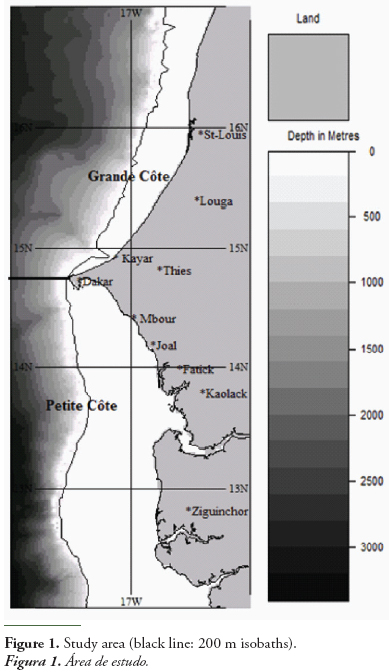
Statistical analysis between Ethmalosa fimbriata catch and the environmental data (SST and Chl-a)
Monthly climatology was calculated in order to analyze the seasonal abundance of E. fimbriata in relation to SST and Chl-a variation.
The relationships between SST and Chl-a, and catch of E. fimbriata were evaluated. The analysis was based on Pearson’s correlation coefficient between catch of E. fimbriata, SST and Chl-a. Correlation coefficient has been checked against the hypothesis that it was zero with a 95% confidence level. To facilitate the visualization of the relationship between the climate descriptors and the catch of E. fimbriata, scatterplots was produced.
To identify a possible relationship between catch of E. fimbriata and SST and Chl-a, a simple linear regression model (lm) was used for describing paired data sets that are related in a linear manner. The package R (version 2.14.1) was used to carry out this study. Seasons were defined as follows: winter (January, February, March), spring (April, May, June); summer (July, August, September), and autumn (October, November, December).
In the analysis, the catch of E. fimbriata was considered as the response (output or y) variable in order to facilitate the analyses and visual comparison of general trends. The explanatory or independent variables used are: the SST and Chl-a. We evaluated the collinearity of these variables with catch of E. fimbriata. We also examined whether the explained variance is increased when they are considered together or separately. Thus, three types of models were studied: (i) combined influence of SST and Chl-a; (ii) effect of the SST solely, and (iii) finally the influence of the Chl-a by itself on catch of E. fimbriata. A natural logarithm was used to transform the SST, Chl-a and catch in order to reduce their variability.
3. RESULTS
Landings variability
The distribution of total landings from the different landing ports in Senegal is shown in figure 2. The landings of E. fimbriata are most important in Thies with 64.9%, followed by Fatick (17.9%), Ziguinchor (12.52%), St-Louis (3.21%), Dakar (1.39%), and Louga (0.07). It’s worth to emphasize that there are three major landings ports in Thies which are Kayar located in the “Grande Côte” Mbour and Joal situated both in the “Petite Côte” (Fig. 1).
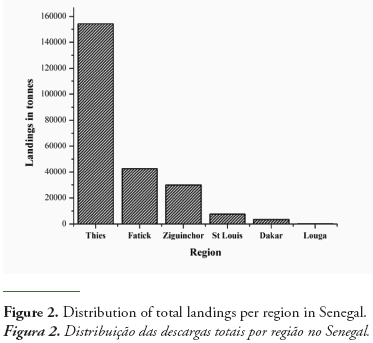
E. fimbriata landings reveal an interannual variability with a decreasing trend (Fig. 3). The average monthly landings between 1999 and 2009 are shown in figure 4. The seasonal pattern of E. fimbriata landings shows that maximum of catch, ranged from 21,093.10 to 27,988.36 and occurred from January-June with a peak in February (Fig. 4). The lowest E. fimbriata landing is observed in September (7,974.67 t). Figure 5 shows distribution of E. fimbriata landings, SST and Chl-a per season, whose 33.7%, 32%, 16.5%, and 17.8% of the total landings were performed in winter, spring, summer, and autumn, respectively.
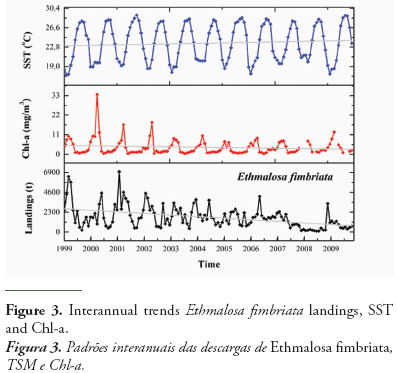
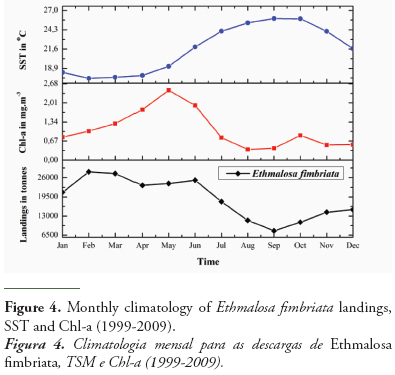
SST variability from the coast to the 200 m isobaths
SST exhibits a gradual increase from 1999 to 2009 in Senegalese waters (Fig. 3). The monthly composite of SST values ranged from 17.50 to 25.86 oC with a mean value of 21.60 oC and a standard deviation of 3.22 oC. The fluctuations in SST have two patterns (Fig. 4). Maximum values were observed from July to December (<22 oC) and lowest values in January to June (>22 oC). June constitutes the transition period between the upwelling season and the warming season. The minimum is observed in February and the highest in September. The SST average per season shows that the lowest temperature is observed in winter and the highest in summer (Fig. 5).
Chl-a variability from the coast to the 200 m isobaths
The interannual variability of Chl-a concentration showed a decreasing trend in the 1999-2009 period (Fig. 3). Monthly Chl-a average from the coast to the 200 m isobaths exhibited two patterns, as did SST (Fig. 4). It showed a period of high Chl-a concentration from January-June with a peak in May and a period of low Chl-a concentration from July-December. The Chl-a concentration values ranging from 0.37 to 2.45m.gm-3, have a mean of 1.06m.gm-3, and a standard deviation of 0.63m.gm-3. The former indicated that Chl-a concentration was highly variable within this period. The seasonal variability of Chl-a concentration showed that the highest concentration was observed during spring and the minimum in summer (Fig. 5).
Relationship between SST, Chl-a and E. fimbriata landings
Significant and negative correlation was calculated between seasonal variability of SST and E. fimbriata landings (r = -0.87, p<0.01) (Fig. 6, left), while Chl-a is positively and significantly correlated with E. fimbriata landings (r = 0.86, p<0.01) (Fig. 6, right). The variation of Ethmalosa landings per season is strongly negatively linked to SST (r = -0.98, p<0.01) (Fig. 7, left), whereas Chl-a is positively related to E. fimbriata landings (r = 0.86, p<0.05) (Fig. 7, right).
Three types of models have been carried out: (1) combined effect of SST and Chl-a and (2) SST and (3) Chl-a effect independently. The seasonal variability of E. fimbriata landings is mainly due to the combined effects of SST and Chl-a, supporting 87.92% of the total variance, whereas SST solely explains 75.69% and Chl-a 73.56%.The mixed effect of SST and Chl-a plays a key role on the variability of E. fimbriata landings per season, explaining 99.17 % of the total variance, while SST and Chl-a contribute 94.08% and 60.38%, respectively.
4. DISCUSSION
The results of this study demonstrated that there is an environmental effect on Ethmalosa fimbriata abundance off coast of Senegal. This can be summarized by the variability of Chl-a through the SST driven effect. The fact that seasonal E. fimbriata landings are strongly related to the combined effect of SST and Chl-a could be the consequence of their effect on E. fimbriata larvae survival, growth rates, and timing of the reproductive peaks.
E. fimbriata landings and Chl-a showed a decreasing trend from 1999 to 2009, while SST increased. It seems that this situation, decreasing trend of Chl-a and SST warming, was unfavorable to E. fimbriata abundance. Besides sea warming, and the decrease of phytoplankton biomass, the general downward trend in E. fimbriata landings could also have been the result of non-climatic influences such as fishing effort. However, this hypothesis can be disregarded because the fishing effort during the 1999-2008 period trends is not correlated (r= -0.05) against E. fimbriata landings (Fig.8).
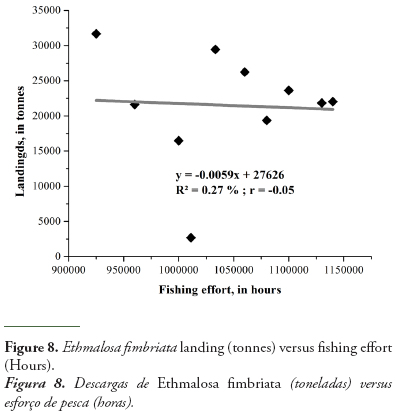
Many studies have suggested that the abundance of small pelagic resources is linked to the spatio-temporal variability of environmental factors such as SST, Chl-a, wind stress, sea surface height, among others (Cury & Roy, 1989; Fréon, 1991; Bakun, 1996; Zagaglia et al., 2004). Cold temperature observed from January to June was favorable to Ethmalosa abundance. According to Bakun (1996), in this period sea surface temperature is significantly and negatively correlated against upwelled waters rich in nutriment. This wind-driven phenomenon induces an increase in phytoplankton and zooplankton biomass abundance which is the base of the food chain of small pelagic resources. It has been demonstrated that the seasonal dynamics of upwelling intensity show that spawning seasons and nursery areas of small pelagic fish are linked to enrichment processes (Demarcq & Faure, 2000; Caverivière et al., 2002).
It must be emphasized that this linear model (lm) presents limitations. Since the relationships between landings and climatic terms (SST and Chl-a) seem not to be totally linear (Figs. 6 and 7). Moreover, it has been demonstrated that interaction between environment and biology is complex due to the non-linear population dynamics response (Rothschild, 2000). We think this phenomenon will be better modelled using non-linear model such as a generalized additive models (GAMs). This model provided an accurate prediction of sardine habitat and its seasonal dynamics (Zwolinski et al., 2011).
CONCLUSIONS
Overall, this study showed that there is a tight link existing between Ethmalosa fimbriata abundance, sea surface temperature and phytoplankton biomass off coast of Senegal. The seasonal abundance of E. fimbriata is strongly governed by the combined effect of SST and Chl-a whereby an increase in SST and a decrease in phytoplankton results in a decrease in the fish abundance.
Sustainable use of marine resources requires effective monitoring and management of fish stocks and fish habitat. Remote sensing satellite data, such as sea surface temperature and ocean color (Chl-a) constitute an important tools to help scientists to develop suitable management strategies for a sustainable fisheries resources management.
However, further investigation should be done using GAMs. This model showed that a non-linear multivariate combination of environment variables could be used to define species habitat better than a range of environmental variables analysed in isolation or in linear combination (Zwolinski et al., 2011).
REFERENCES
Abowei, J.F.N. (2009) - The Morphology, Abundance, Condition Factor and Length-weight Relationship of Ethmalosa fimbriata (Bowdish 1825) from Nkoro River Niger Delta, Nigeria. Advance Journal of Food Science and Technology 1(1):51-56. Available on-line at http://maxwellsci.com/print/ajfst/51-56.pdf [ Links ]
Bakun, A. (1996) - Patterns in the Ocean: Ocean Processes and Marine Population Dynamics. 323pp., University of California Sea Grant, San Diego, California, USA, in cooperation with Centro de Investigaciones Biologicas de Noroeste, La Paz, Baja California Sur, Mexico. ISBN 1-888696-018. Available on-line at http://www.seaaroundus.org/researcher/dpauly/PDF/1997/JournalArticles/ReviewOfPatternsInTheOceans.pdf [ Links ]
Belkin, I.M. (2009) - Rapid warming of Large Marine Ecosystems. Progress in Oceanography 81: 207–213. doi: 10.1016/j.pocean.2009.04.011
Binet, D.; Gobert, B.; Maloueki, L. (2001) - El Nino-like warm events in the Eastern Atlantic (6°N, 20°S) and fish availability from Congo to Angola (1964–1999). Aquatic Living Resources 14:99–113. Available on-line at http://horizon.documentation.ird.fr/exl-oc/pleins_textes/pleins_textes_7/b_fdi_57-58/010025345.pdf
Butler, M.J.A.; Mouchot, M.C.; Barale, V.; LeBlanc, C. (1988) - The application of remote sensing technology to marine fisheries: an introductory manual. 165p., FAO Fish. Tech. Pap. 295, FAO - Food and Agriculture Organization of the United Nations, Rome, Italy. ISBN: ISBN 92-5-102694-7. Avaliable on-line at http://www.fao.org/docrep/003/t0355e/t0355e00.HTM [ Links ]
Caverivière A.; Thiam M.; Jouffre D. (eds.) (2002) – Le poulpe commun Octopus vulgaris. Sénégal et côtes nord-ouest africaines. 385p., éditions IRD, Paris, France. ISBN: 2709914816. Avaliable on-line at http://horizon.documentation.ird.fr/exl-doc/pleins_textes/divers09-03/010029142.pdf
Chassot, E.; Mélin, F.; Le Pape, O.; Gascuel, D. (2007) - Bottom-up control regulates fisheries production at the scale of eco-regions in European seas. Marine Ecology Progress Series 343: 45-55. doi: 10.3354/meps06919 [ Links ]
Cury, P.; Roy, C. (1989) - Optimal environmental window and pelagic fish recruilmenl success in upwelling areas. Canadian Journal of Fisheries and Aquatic Sciences 46: 670·680. Available on-line at ftp://134.246.142.21/ifremer/ird/roy/PDF/Cury&Roy,1989.pdf [ Links ]
Cushing, D.H. (1982) - Climate and Fisheries. 373p., Academic Press, London & New York. ISBN: 9780121997205. [ Links ]
Demarcq, H.; Faure, V. (2000) - Coastal upwelling and associated retention indices derived from satellite SST. Application to Octopus vulgaris recruitment. Oceanologica Acta, 23(4):391-408. doi: 10.1016/S0399-1784(00)01113-0 [ Links ]
Diei-Ouadi, Y. (2005) - Minced sardinella fillets in fishlanding and marketing sites in Senegal. 20p., FAO Fisheries Circular no. 999, FAO - Food and Agriculture Organization of the United Nations, Rome, Italy. Avaliable on-line at ftp://ftp.fao.org/docrep/fao/008/a0101e/a0101e00.pdf [ Links ]
Fréon, P. (1991) - L’introduction d’une variable climatique dans les modèles globaux de production. In: Philippe Cury & Claude Roy (eds.), Pêcheries ouest africaines: variabilité, instabilité et changement, pp.395-424, ORSTOM, Paris, France. ISBN: 2709910403. Avaliable on-line at http://horizon.documentation.ird.fr/exl-doc/pleins_textes/divers11-10/36276.pdf
Gordoa, A.; Maso, M.; Voges, L. (2000) - Satellites and fisheries: The Namibian hake, a case study. In: D. Halpern (ed.), Satellites, Oceanography and Society, pp.193-205, Elsevier, Amsterdam, The Netherlands. DOI: 10.1016/S0422-9894(00)80011-2 [ Links ]
IPCC (2007) - Summary for Policymakers. In: S. Solomon, D. Qin, M. Manning, Z. Chen, M. Marquis, K.B. Averyt, M. Tignor & H.L. Miller (eds.), Contribution of Working Group I to the Fourth Assessment Report of the Intergovernmental Panel on Climate Change, pp.1-18, Cambridge University Press, Cambridge, U.K. and New York, NY, U.S.A. Avaliable on-line at http://www.ipcc.ch/pdf/assessment-report/ar4/wg1/ar4-wg1-spm.pdf [ Links ]
Jallow, A.M. (1994) - Utilization of bonga (Ethmalosa fimbriata) in West Africa. 28p., FAO Fisheries Circular No. 870, FAO - Food and Agriculture Organization of the United Nations, Rome, Italy. Avaliable on-line at http://www.fao.org/docrep/005/t3536e/t3536e00.htm [ Links ]
Klemas, V. (2012) - Remote Sensing of Coastal and Ocean Currents: An Overview. Journal of Coastal Research 28(3):576–586. doi: 10.2112/JCOASTRES-D-11-00197.1
Laevastu, T.; Hayes, M.L. (1981) - Fisheries Oceanography and Ecology. 199p., Fishing News (Books), Oxford, U.K. ISBN: 9780852381175. [ Links ]
Rothschild, B.J. (2000) - Fish stocks and recruitment: the past thirty years. ICES Journal of Marine Science, 57: 191–201. doi:10.1006/jmsc.2000.0645
Sherman, K.; Belkin, I.; Friedland, K.; O’Reilly, J.; Hyde, K. (2009) - Accelerating warming and emergent trends in fishing biomass yields of the world’s Large Marine Ecosystems. AMBIO, 38(4): 215-224. doi:10.1579/0044-7447-38.4.2.215.
Sund, P.N.; Blackburn, M.; Williams, F. (1981) - “Tuna and Their Environment in the Pacific Ocean: A Review. Oceanogr,” Oceanography and Marine Biology: An Annual Review 19: 443-512.
Ware, D.M.; Thomson, R.E. (2005) - Bottom-up ecosystem trophic dynamics determine fish production in the northeast Pacific. Science, 308(5726):1280-1284. doi: 10.1126/science.1109049 [ Links ]
Zainuddin, M.; Saitoh, K.; Saitoh, S. (2004) - Detection of potential fishing ground for albacore tuna using synoptic measurements of ocean color and thermal remote sensing in the northwestern North Pacific. Geophysical Research Letters, 31(20):L20311. doi: 10.1029/2004GL021000 [ Links ]
Zagaglia, C.R.; Lorenzzetti, J.; Stech, J.L. (2004) - Remote sensing data and longline catches of yellowfin tuna (Thunnus albacores) in the equatorial Atlantic. Remote Sensing of Environment, 93(1-2): 267-281. doi: 10.1016/j.rse.2004.07.015 [ Links ]
Zwolinski, J.P; Emmett, R.L.; Demer, D.A. (2011) - Predicting habitat to optimize sampling of Pacific sardine (Sardinops sagax). ICES Journal of Marine Science, 68(5):867–879. doi: 10.1093/icesjms/fsr038
*Submission: 3 June 2013; Evaluation: 15 July 2013; Reception of revised manuscript: 23 July 2013; Accepted: 2 August 2013; Available on-line: 3 September 2013
**Portuguese Title and captions by Ulisses M Azeiteiro on behalf of the Journal Editorial Board














